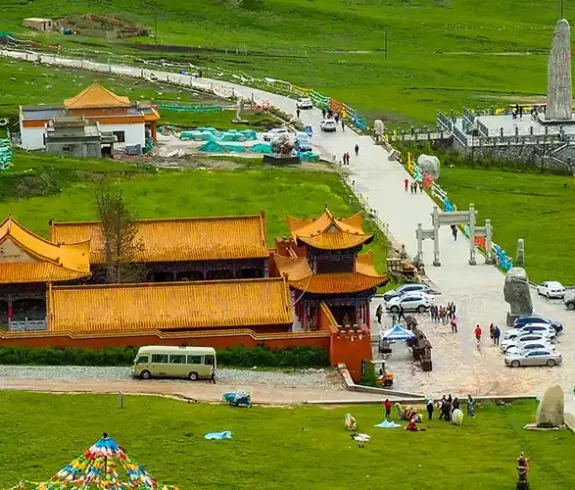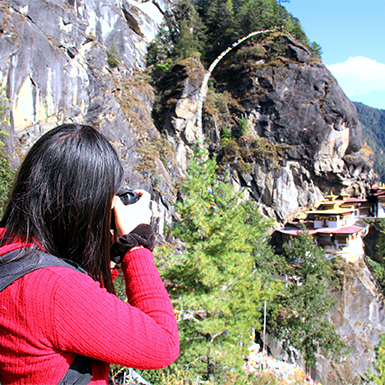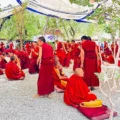Step back in time and discover the remarkable story of Songtsen Gampo, a 7th-century Tibetan king who left an indelible mark on his nation’s history. Renowned as the 33rd king of the Yarlung dynasty, his reign ushered in a golden age for Tibet, characterized by territorial expansion, cultural reforms, and the introduction of Buddhism.
A Visionary Leader
Songzan Ganbu’s ambition and strategic prowess are undeniable. He united the warring Tibetan tribes through military campaigns and founded the powerful Tibetan Kingdom. This empire stretched across vast swathes of Central Asia, encompassing regions of modern-day China, Nepal, Bhutan, and India. His reign marked a turning point, transforming Tibet from a fragmented collection of tribes into a formidable force on the Asian political scene.
Songtsen Gampo Reforms: Laying the Foundation for a Cohesive Nation
Recognizing the need for a unified identity within his newly formed empire, Songzan Ganbu launched a series of significant reforms. He standardized weights and measures, established a legal code, and, most importantly, received credit for creating the Tibetan writing system. This writing system, based on an adaptation of the Indian script, became instrumental in preserving Tibetan culture and religious texts.

The Influence of Songtsen Gampo’s Wives
Songtsen Gampo’s strategic marriages secured political alliances and played a crucial role in shaping Tibetan culture. Jokhang Temple in Lhasa, one of the most sacred sites in Tibet, was constructed under the influence of Bhrikuti, his first wife, a princess from Nepal who is said to have introduced Buddhism into Tibet.
Later, Songzan Ganbu married Princess Wencheng, a Tang Dynasty Chinese princess. This marriage not only cemented ties with China but also exposed Tibet to advancements in Chinese art, architecture, and governance. The cultural exchange fostered during this period significantly influenced Tibetan artistic traditions.
The Tibetan Empire: A Flourishing Era
Songtsen Gampo’s reign witnessed a flourishing of Tibetan culture and the beginning of a long-lasting relationship with Buddhism. The empire became a trade and cultural exchange hub, attracting scholars and artisans from neighboring regions. His legacy extends beyond territorial expansion; he is revered as the “Great Dharma King” for laying the groundwork for the deep-rooted Buddhist traditions that define Tibetan culture today.
Early Life and Rise to Power
The early life of Songzan Ganbu remains shrouded in some mystery. Historical accounts vary, but all agree on his pivotal role in shaping Tibetan history. He was born in the early 7th century AD and belonged to the Yarlung dynasty, which ruled over a fragmented collection of Tibetan tribes.
A Swift Rise to Power
Scholars debate the details surrounding Songtsen Gampo’s ascent to the throne. Some sources suggest he faced challenges from rivals within the Yarlung dynasty. However, his ambition and strategic brilliance shone through. He emerged victorious, consolidating power and uniting various Tibetan tribes under his banner. This unification marked a crucial step in establishing the Tibetan Empire.
Consolidating Power: A United Tibet
Songzan Ganbu’s reign wasn’t simply about military conquest. He understood the importance of a unified identity for his newly formed empire. Here’s how he consolidated his power:
- Military Campaigns: He launched strategic military campaigns, expanding Tibetan territory significantly. These campaigns brought regions of modern-day China, Nepal, Bhutan, and India under Tibetan control.
- Centralized Authority: He established a strong central administration, replacing tribal leadership with a more unified governing structure. This centralized power ensured control over the vast Tibetan Empire.
- Cultural Reforms: Recognizing the need for a cohesive national identity, Songzan Ganbu enacted reforms. These included the standardization of weights and measures, the creation of a legal code, and, most importantly, the development of a writing system based on the Indian script. This writing system became the foundation for preserving Tibetan culture and religious texts.
Forging an Empire and Embracing Buddhism
Songtsen Gampo’s brilliance extended beyond the war. He understood the importance of a unified identity for his newly formed empire. Here’s how he consolidated his power and expanded the Tibetan Empire:
Military Prowess
A skilled strategist, Songzan Ganbu launched strategic campaigns, significantly expanding Tibetan territory. These conquests brought vast regions under his control, encompassing parts of modern-day China, Nepal, Bhutan, and India.
Strategic Alliances
Recognizing the value of diplomacy, Songtsen Gampo formed crucial alliances through marriages with influential princesses. These Songzan Ganbu Wives played a significant role beyond strengthening the empire’s stability.
- Bhrikuti, Princess of Nepal: Marrying Bhrikuti to a political alliance with Tibet was the beginning of Nepal. Many believe she was responsible for introducing Buddhism to Tibet during a crucial time for the country. The building of the Jokhang Temple in Lhasa by King Songtsen Gampo, with influence from his wife Bhrikuti, shows how important she was to this country as well.
- Wencheng, Princess of the Tang Dynasty: His marriage to Princess Wencheng of China solidified ties with the powerful Tang Dynasty. This alliance ensured peace on the eastern borders and exposed Tibet to Chinese art, architecture, and governance advancements. The cultural exchange fostered during this period significantly influenced Tibetan artistic traditions.
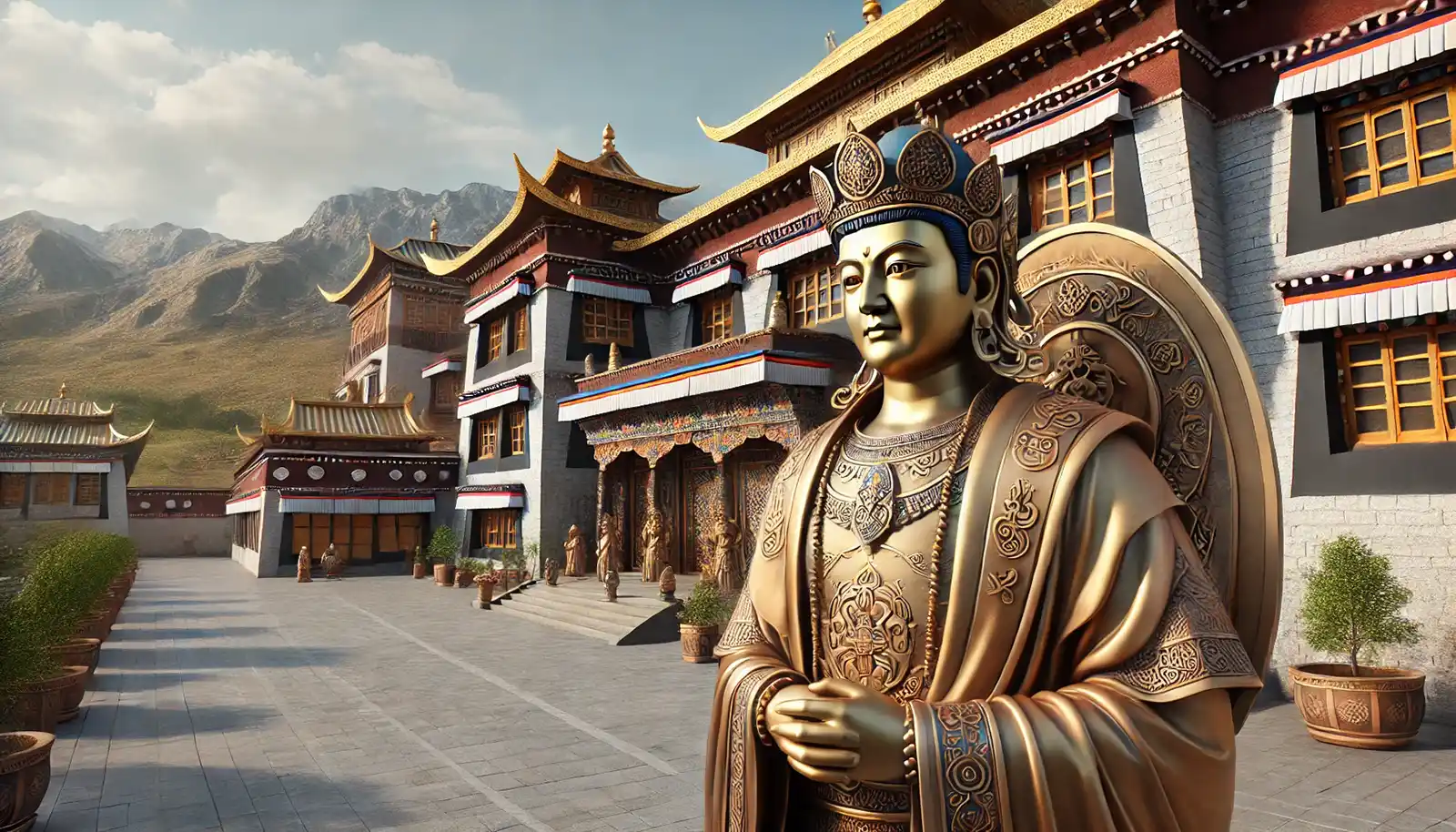
The Arrival of Buddhism: A Cultural Transformation
One cannot overstate Songtsen Gampo’s pivotal role in introducing Buddhism to Tibet. His marriage to Bhrikuti and his openness to Buddhist teachings paved the way for this transformative religion to take root. The influence of Buddhism extended far beyond the religious sphere, permeating:
- Art and Literature: Buddhist themes and imagery became prominent in Tibetan art, with monasteries becoming centers of artistic creation. Religious texts were translated from Sanskrit into Tibetan, enriching the literary landscape.
- Social Structures: Buddhist principles of non-violence and compassion influenced Tibetan society. Monasteries emerged as centers of learning and social welfare, creating a sense of community.
A Legacy of Cultural and Social Reforms
Songtsen Gampo’s reign focused not only on military conquest and territorial expansion. He recognized the need for a unified identity and social cohesion within his newly formed Tibetan Empire. He initiated a series of significant Songzan Ganbu Reforms that impacted Tibetan culture and society to achieve this.
Laying the Foundation for a Cohesive Nation
Songtsen Gampo understood that a vast empire with diverse populations needed unifying elements. Here’s how his reforms addressed this challenge:
- The creation of the Tibetan Script is one of Songzan Ganbu’s most significant achievements. He commissioned Thonmi Sambhota, a minister, to develop a script based on the Indian script. This creation, the Tibetan script, facilitated the translation of Buddhist texts and the spread of literacy throughout the empire. It became instrumental in preserving Tibetan culture and religious traditions.
- Codification of Laws: Before Songtsen Gampo’s reign, laws varied across Tibetan regions. He created a uniform legal code to ensure that justice was served the same way in all areas of the country; this move helped to achieve national harmony and avoid any confusion in various parts of the country.
- Standardization of Weights and Measures: Songzan Ganbu established a uniform system of weights and measures across his vast empire to simplify trade and commerce. This system removed confusion and promoted smooth buying and selling activities between territories.
The Impact of Songtsen Gampo’s Reforms
These reforms by Songzan Ganbu went beyond mere practicality. They played a crucial role in:
- Unifying the Empire: A standard script, legal code, and system of weights and measures fostered a shared identity among the empire’s diverse populations.
- Preserving Culture: The creation of the Tibetan script allowed for the recording and preserving of Tibetan history, literature, and religious texts.
- Spreading Buddhism: The ability to translate Buddhist texts into Tibetan facilitated the spread of this transformative religion throughout the empire.
Songtsen Gampo’s Strategic Marriages: A Boon for the Tibetan Empire
Songtsen Gampo’s reign witnessed remarkable growth for the Tibetan Empire. After military victories, her clever marriages to influential princes played an essential role in shaping the political and cultural landscape of the empire. Let’s delve into the influence of his marriages with Princess Bhrikuti of Nepal and Princess Wencheng of the Tang Dynasty.
Marriages with Far-Reaching Impact
Songtsen Gampo’s carefully chosen marriages transcended mere political alliances. These unions brought significant benefits to the Tibetan Empire:
- Political Alliances: Marrying Bhrikuti and Wencheng solidified Tibet’s position on the Asian political stage. The alliance with Nepal ensured peace on the western borders, while the union with the mighty Tang Dynasty secured the eastern flank. These alliances allowed Songzan Ganbu to focus on internal reforms and expansion in other directions.
- Cultural Exchange: The arrival of the princesses wasn’t just about political ties; it opened doors to rich cultural exchange. Bhrikuti, a devout Buddhist, is credited with introducing Buddhism to Tibet. This event marked a turning point, shaping Tibetan art, literature, and social structures for centuries. Princess Wencheng, hailing from the Tang Dynasty, brought Chinese art, architecture, and governance advancements. These influences are evident in Tibetan artistic traditions, particularly during this period.
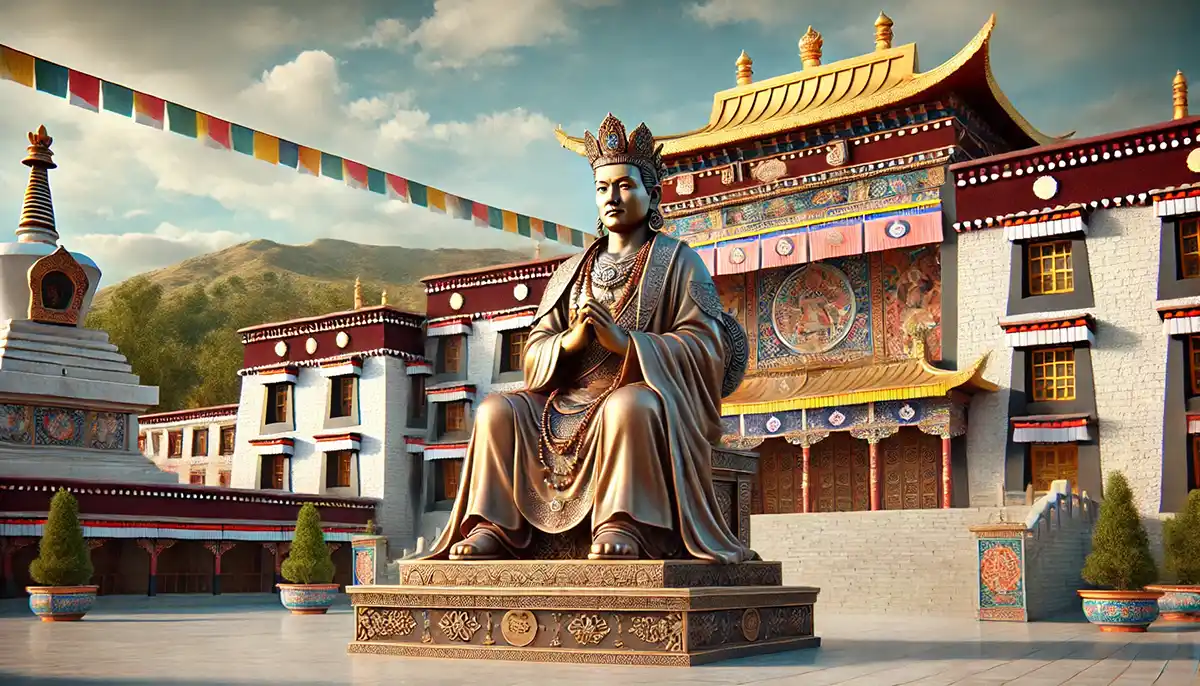
A Legacy of Buddhism
The most significant impact of Songtsen Gampo’s marriages lies in introducing Buddhism to Tibet. Bhrikuti’s influence and Songzan Ganbu’s receptiveness to Buddhist teachings paved the way for this transformative religion to take root. Today, the construction of the Jokhang Temple in Lhasa, the center of Tibetan Buddhist pilgrimage, is a testament to the activity Bhrikuti played. Buddhism’s influence extended far beyond the religious sphere. Here’s how it transformed Tibetan culture:
- Art and Literature: Buddhist themes and imagery became prominent in Tibetan art, with monasteries becoming centers of artistic creation. Religious texts were translated from Sanskrit into Tibetan, enriching the literary landscape.
- Social Structures: Buddhist principles of non-violence and compassion influenced Tibetan society. Monasteries emerged as centers of learning and social welfare, fostering a sense of community.
Architectural Contributions
Songtsen Gampo’s reign wasn’t just about military might and cultural reforms; it was also a period of significant architectural achievements. Two structures, in particular, stand as testaments to his vision and remain central to Tibetan Buddhism today: the Jokhang Temple and the Ramoche Temple.
Jokhang Temple: A Beacon of Buddhism
The Jokhang Temple in Lhasa is arguably the most sacred site in Tibetan Buddhism. Songtsen Gampo’s wives played a significant role in the construction. Many credit Bhrikuti, a devout Buddhist princess from Nepal, for introducing Buddhism to Tibet. The Jokhang Temple’s construction, believed to have been initiated by Songtsen Gampo himself, was a physical manifestation of this new faith. Here’s what makes the Jokhang Temple so significant:
- Architectural Style: The temple’s unique architectural style blends Tibetan and Nepalese influences. It features a central mandala layout, symbolizing the Buddhist universe, and houses a life-sized statue of Jowo Shakyamuni, believed to have been brought to Tibet by Princess Bhrikuti.
- Pilgrimage Site: Over the centuries, the Jokhang Temple has become a central pilgrimage site for Tibetan Buddhists. Pilgrims from all walks of life come to pay homage to the Jowo Shakyamuni statue and participate in religious ceremonies.
Ramoche Temple: A Symbol of Harmony
Another architectural marvel linked to Songtsen Gampo is the Ramoche Temple, opposite the Jokhang Temple. While the exact date of construction remains debated, it’s believed to have been built by Songzan Ganbu to appease a wrathful earth goddess who opposed the construction of the Jokhang Temple. Here’s what makes the Ramoche Temple noteworthy:
- Architectural Significance: The Ramoche Temple showcases a unique architectural style distinct from the Jokhang Temple. It features a circular layout and houses a revered statue of Tara, the female embodiment of enlightened activity.
- Complementary Role: The Ramoche Temple complements the Jokhang Temple, representing the balance between male and female energies in Tibetan Buddhism.
A Legacy Etched in Stone and Faith
Songtsen Gampo, the 7th-century king of Tibet, wasn’t just a ruler but a transformative figure who shaped the essence of Tibetan identity. His reign witnessed the rise of the Tibetan Empire, but his true legacy lies in the profound cultural and religious shifts he ushered in.
The Enduring Impact of a Visionary King Songtsen Gampo
The impact on Tibet is undeniable. Here’s how his reign continues to resonate today:
- Unified Tibetan Culture: Through military conquests, strategic alliances with his Songtsen Gampo Wives, and crucial reforms, he forged a unified Tibetan identity. Creating a writing system and standardizing weights and measures fostered a sense of national cohesion.
- The Cradle of Tibetan Buddhism: Songtsen Gampo’s introduction of Buddhism, likely influenced by Bhrikuti, marked a pivotal moment. Buddhism permeated Tibetan art, literature, and social structures, shaping the unique Buddhist identity Tibet is known for today. Structures like the Jokhang Temple stand as testaments to this enduring legacy.
- A Buddhist Revered Figure: The Tibetan Buddhist tradition reveres Songtsen Gampo as a bodhisattva, a being on the path to enlightenment who chooses to remain on Earth to help others. This reverence reflects his profound impact on establishing Buddhism as the cornerstone of Tibetan culture.
Beyond the Battlefield: A Lasting Legacy
During his rule, he went past military conquest. He was a leader with a forward-thinking mentality, and he knew cultural and social unity was needed. Today, a unique Tibetan identity exists due to his changes, strategic unions, and adoption of Buddhism.
Songtsen Gampo: A Legacy That Endures
The 7th-century king of Tibet wasn’t just a ruler; he was a visionary leader who reshaped the destiny of his nation. His reign witnessed the rise of a mighty Tibetan Empire, but his true legacy lies in the profound cultural and religious transformations he championed.
A Legacy Carved in Culture and Faith
Songtsen Gampo’s impact extends far beyond his conquests. Here’s how his reign continues to shape modern Tibet:
- Unified Tibetan Identity: Through his conquests, strategic alliances with his Songtsen Gampo Wives, and crucial Songzan Ganbu Reforms, he forged a unified Tibetan identity. Creating a writing system and standardized weights and measures fostered a sense of national cohesion that endures today.
- The Cradle of Tibetan Buddhism: The introduction of Buddhism, likely influenced by Bhrikuti, marked a pivotal moment. It permeated Tibetan art, literature, and social structures, shaping the unique Buddhist identity Tibet is known for. Structures like the Jokhang Temple stand as testaments to this enduring legacy.
- A Revered Figure: Followers of the Tibetan Buddhist tradition worship Songzan Ganbu as a bodhisattva. A bodhisattva is someone who, due to their enlightenment, chooses to remain on Earth to guide others toward their enlightenment. His significant influence in establishing Buddhism as the basis of Tibetan civilization explains why he commands such respect.
Beyond the Battlefield: A Visionary Leader
His rule extended far beyond mere warfare; he envisioned a unified future for his country, recognizing cultural and social homogeneity as essential. These measures, combined with strategic partnerships and the conversion to Buddhism, unprecedentedly paved the way for a flourishing Tibetan identity.
Planning Your Trip to the Land of Snows
A trip to Tibet offers a journey through history. Explore architectural marvels like the Jokhang and Ramoche Temple, which are linked to Songzan Ganbu’s legacy. Witness the vibrant tapestry of Tibetan Buddhist traditions and delve into a culture shaped by a remarkable king who continues to inspire awe centuries after his reign.
